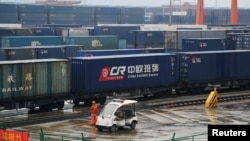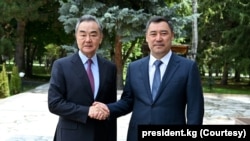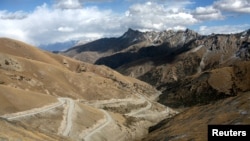The latest talks between China, Kyrgyzstan and Uzbekistan have renewed hopes that an ambitious planned railway linking these central Asian countries may finally become a reality. But the history of this project is filled with two decades of false starts and dashed expectations.
Following a July 30 meeting with Chinese Foreign Minister Wang Yi, who also visited Tashkent last week for the Shanghai Cooperation Organization (SCO) foreign ministers' meeting, Kyrgyz President Sadyr Japarov’s office said Bishkek wants to sign the agreement at an SCO summit in Samarkand, Uzbekistan, Sept. 15-16.
Kyrgyz officials said Wang also told them Beijing is considering finalizing the deal at the summit.
China’s Ministry of Foreign Affairs said following the meeting with Japarov that “the conditions and time for the construction of the China-Kyrgyzstan-Uzbekistan (CKU) railway are getting ripe, and the first batch of Chinese experts have arrived in Kyrgyzstan recently for a site survey and the construction process of this railway has kicked off. China stands ready to work with Kyrgyzstan and Uzbekistan to speed up the feasibility study.”
“There will be jobs. Our economy will boom,” Japarov said two months ago, expressing confidence that construction will start next year.
Uzbek President Shavkat Mirziyoyev said the project is key to reaching global markets.
“The China-Kyrgyzstan-Uzbekistan railway will link us to Asia-Pacific countries, paving the way for new economic opportunities. It will be a great addition to the existing East-West railways,” Mirziyoyev said at a May 27 meeting of the Eurasian Economic Union (EEU), where his country has observer status.
Frank Maracchione at Britain’s University of Sheffield and Washington-based Oxus Society for Central Asian Affairs, assesses that the ongoing CKU study is a step forward.
“These next few weeks will be an important indication of whether the plan will proceed. In my recent conversations in Uzbekistan, I did not hear any lack of trust in the development of the project,” Maracchione told VOA.
Tashkent has maintained since the early 2000s that CKU would provide the shortest route from China to markets in the Middle East and Europe. Some analysts say Russia is concerned because the project would divert traffic away from its territory, but Moscow expressed interest in 2019 and allotted $3 million for a feasibility study.
Competing interests
Analysts say economic and geopolitical obstacles exist that may continue to be challenges for the CKU.
“Kyrgyzstan wants it (CKU) to pass its trade hubs and not just follow the faster route, but this impacts financial and technical feasibility,” Maracchione said.
“Kyrgyzstan has less to gain in terms of connectivity as it borders China and is less impacted by the current lack of fast routes to the country,” he contends. “The project could also cause resentment from the public, which is already wary of China’s influence. ... And the country is weaker than others, more vulnerable to Russian geopolitical threats and might suffer from sudden policy changes and retaliations.”
Kyrgyz observer Sovetbek Zikirov said Chinese interests will take priority in CKU project decisions.
“China is an economic superpower in the region,” he told VOA, arguing that Bishkek will not be able to insist on its needs.
Beijing is believed to see the new route as an alternative to its current dependence on a route through Russia and Kazakhstan for overland transit to Europe. That has become even more important in light of the Russian war on Ukraine.
“Russia seems to have accepted the endeavor since it is now among the priority projects of the EEU,” said Maracchione.
Opportunities for Central Asia
Analyst Erkin Abdurazzoqov sees the CKU creating opportunities for Kyrgyzstan.
“If this route opens, our country will be able to sell its food products as well (as) metal and other goods through China. It could also bring more merchandise from China to our bazaars, which could lower prices, pleasing consumers,” Abdurazzoqov said.
The route would generate transit fees for Kyrgyzstan and Uzbekistan and develop local manufacturing industry.
In Uzbekistan, the railway would pass the densely populated Fergana Valley.
Maracchione said a gigantic tunnel into this valley is already seen as one of the most useful Chinese projects in the country.
“Short-term benefits are mainly connected to construction of the railway since Chinese companies tend to hire local workers, partly because of the Uzbek labor laws, while long-term benefits are related to trade opportunities.”
Roadblocks and routes
Earlier this summer, Kyrgyz Transport and Communications Minister Erkinbek Osoyev presented a preliminary route of the railway that would go through Torugart, Makmal and Jalal-Abad. Torugart is a high-altitude mountain pass in the Tian Shan range between Kyrgyzstan’s Naryn and China’s Xinjiang regions. Osoyev explained that the Kyrgyz railway would connect with the Chinese line in Kashgar, Xinjiang and then with its rails, roads and air.
In June, China’s Deputy Minister of Commerce Wang Shouwen said Beijing is eager to implement the plan and is helping Kyrgyzstan to upgrade its highways. Wang and other Chinese officials have pledged to increase imports, including of Kyrgyz agricultural products. Kyrgyzstan has even sought to open a Kyrgyz branch of Alibaba, China’s e-commerce and tech platform.
Experts say logistical challenges and underinvestment have been the main difficulties in realizing this project. Kyrgyz officials admit their part is costlier because nearly 100 tunnels and weather resistant infrastructure could be necessary across the country’s mountainous topography.
Agreement on track gauge is also needed: China uses the international standard of 1,435 mm, while Uzbekistan and Kyrgyzstan’s railways are on wider tracks, a Soviet legacy. Industry experts caution that remedying gauge differences can cost money and time.
They also emphasize that a final route map will need budget clarity, currently estimated at $4.5 billion.
China has said over the years that CKU would form the southern part of a China-Europe freight corridor, linking Central and Eastern Europe via Iran and Turkey.
This report originated in VOA's Uzbek Service. Davron Hotam contributed.










